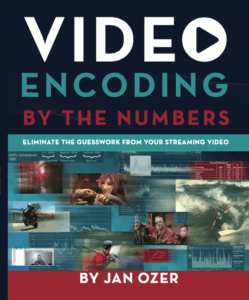 One of the least well known features of the book, Video Encoding by the Numbers, is the content related to FFmpeg. Specifically, for most operations discussed in the book, from setting resolution and data rate to segmenting a file for HLS delivery, the book details the corresponding FFmpeg commands. The latest review up on Amazon includes a major description of how the reader (verified purchase) found this FFmpeg-related content useful.
One of the least well known features of the book, Video Encoding by the Numbers, is the content related to FFmpeg. Specifically, for most operations discussed in the book, from setting resolution and data rate to segmenting a file for HLS delivery, the book details the corresponding FFmpeg commands. The latest review up on Amazon includes a major description of how the reader (verified purchase) found this FFmpeg-related content useful.
The review starts with background information. “This book is amazing. I have been a film / video editor for over 20 years and when making outputs, there are simply many little settings you just either take for granted or ignore. This book explains them all and is outstanding for a number of reasons.”
After making two other points (the book is easy to understand, all recommendations are backed by objective quality metrics), here’s the section on FFmpeg:
FFMPEG examples accompany every variable change. This is huge. There are many good pieces of encoding software; However, FFMPEG is the one the big players use and its free and you put it in scripts making it so customizable. It’s a command line utility that you can control all the variables while encoding and although its not simple, with time, it can be mastered by reading by the documentation and experimenting. Want a short cut to getting applied results? This Video Encoding book makes it happen. Like having a confident hand on your shoulder as you play with all these settings.
Thanks for writing this book. In all my reattaching on the web, there seems to be nothing else like it.
Thanks Doug! My goal was to make the book the best available book for FFmpeg video producers, and I’m glad you found it useful.
You can read Doug’s entire review here, and read more about the Video Encoding by the Numbers, here.
 Streaming Learning Center Where Streaming Professionals Learn to Excel
Streaming Learning Center Where Streaming Professionals Learn to Excel







